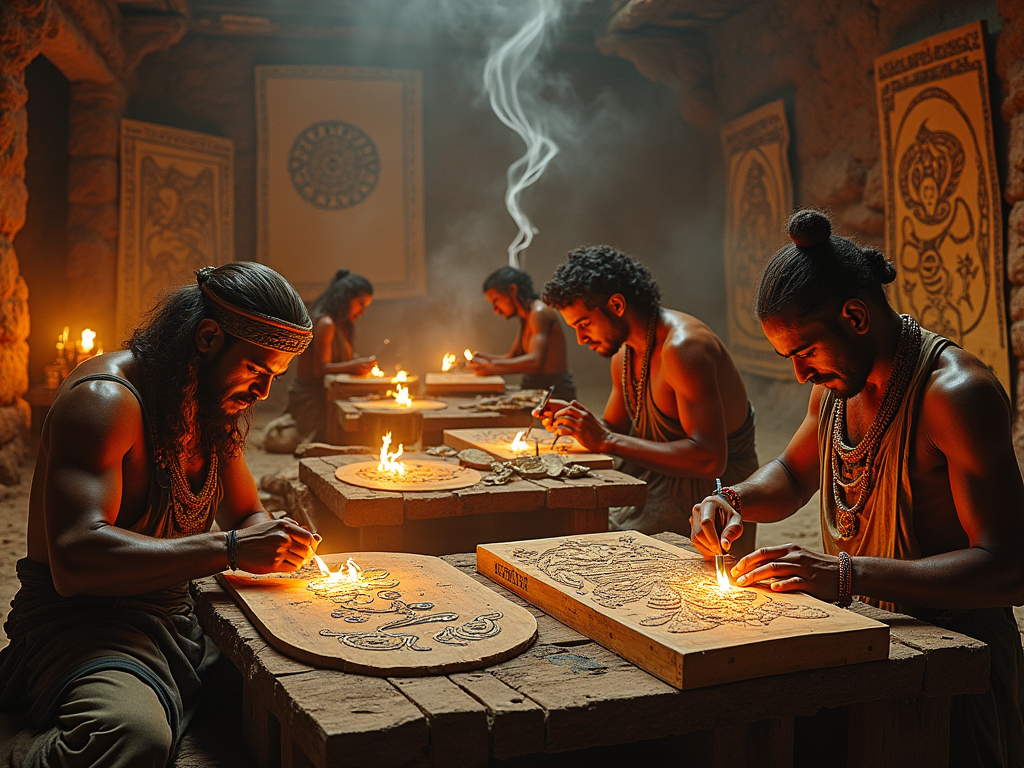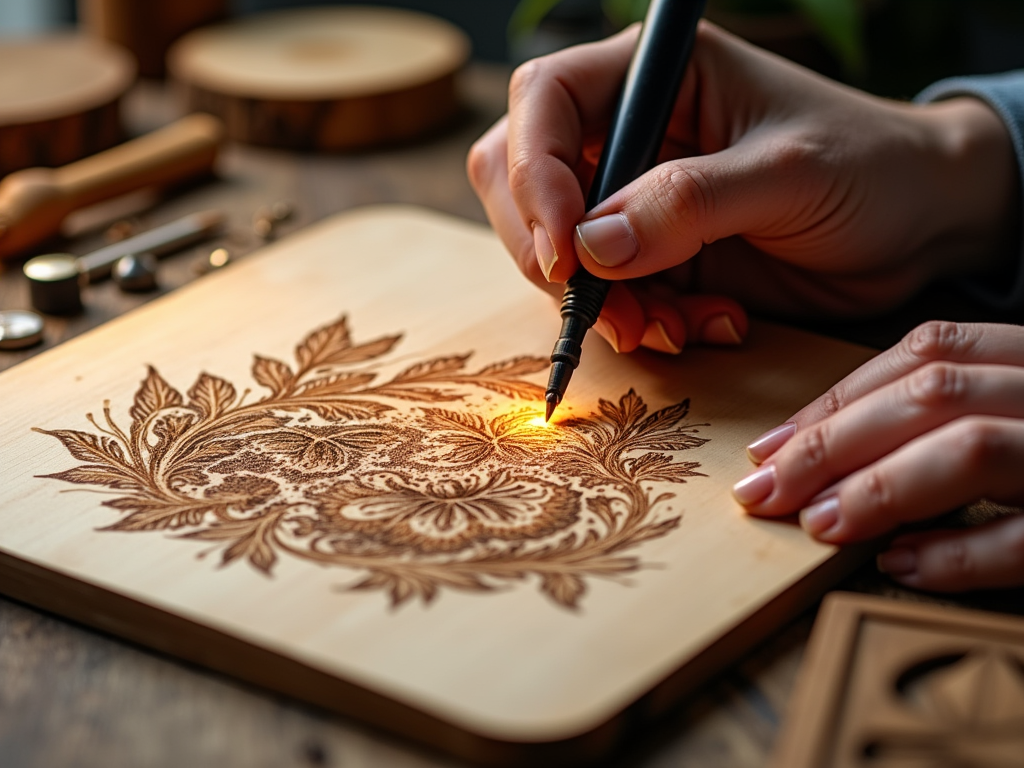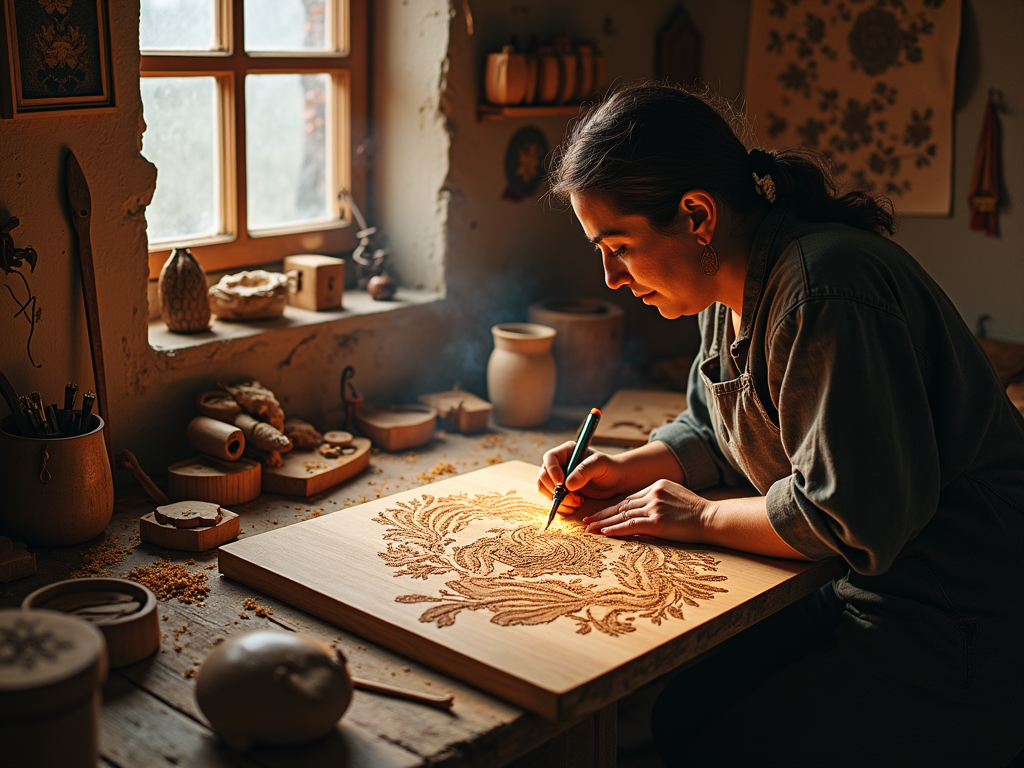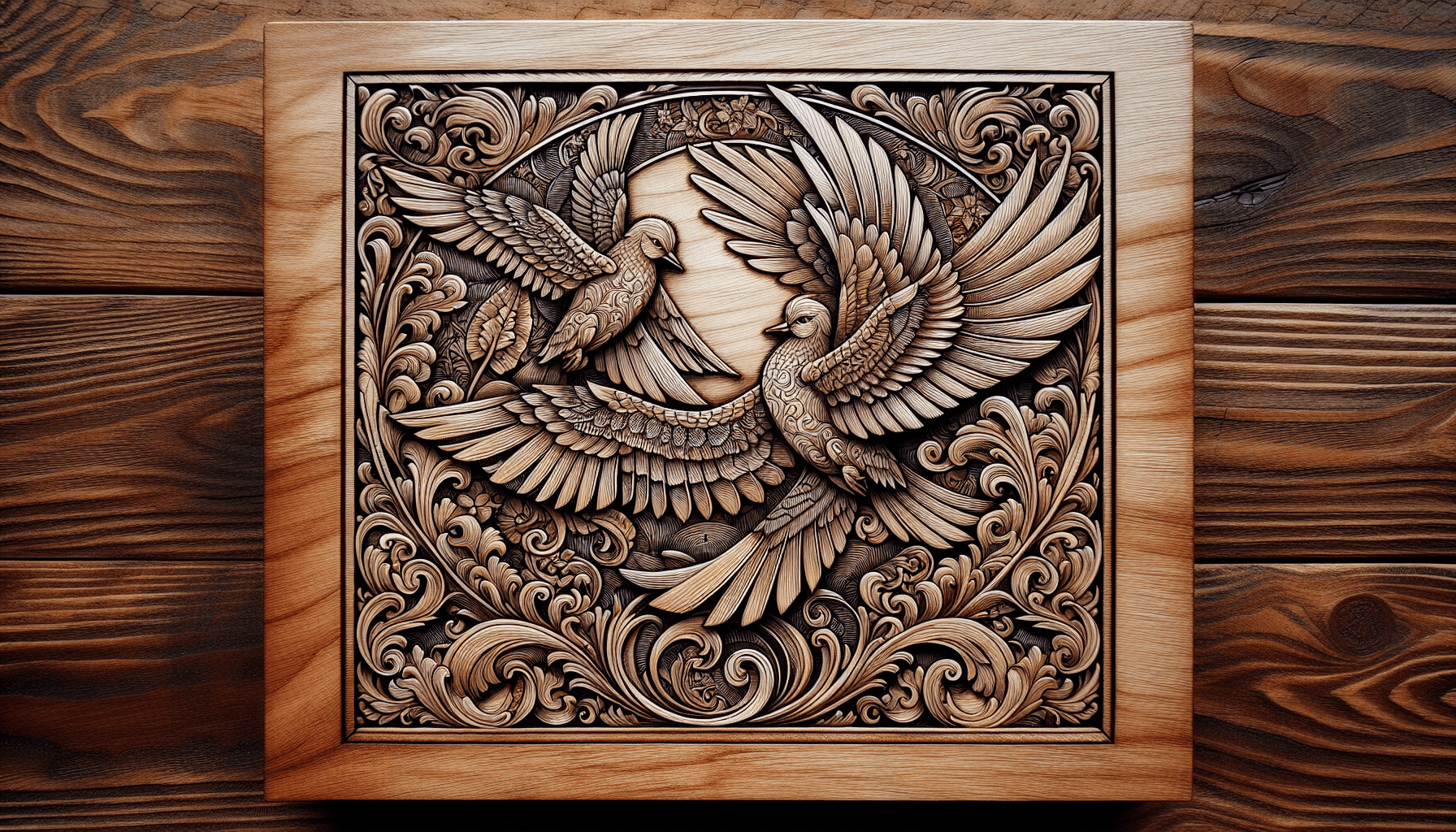I practice pyrography as both a precise craft and expressive art form by burning intricate designs into wood surfaces. My experience has shown how this distinctive medium transforms simple wood pieces into striking artistic creations through skilled burning techniques.
Key Takeaways
- Pyrography requires both technical skill in wood burning and artistic vision, making it both an art form and a craft.
- The medium has evolved from ancient civilizations’ basic tools to modern sophisticated equipment with precise temperature control.
- Contemporary pyrography ranges from functional decorated items to pure artistic expressions in galleries.
- Professional artists have elevated the medium through detailed portraits, landscapes, and abstract compositions.
- The permanence and unique characteristics of burned wood designs distinguish pyrography from traditional art mediums.
I’ve mastered this craft by combining technical burning methods with artistic sensibilities. The practice started with basic decorative markings in ancient times but has grown into an advanced artistic medium. My work spans simple home decor to elaborate fine art pieces displayed in galleries.
Each burned line and shaded area creates permanent marks that give pyrography its distinct character. Modern temperature-controlled tools let me achieve precise effects impossible with traditional implements. I can produce photorealistic portraits, detailed nature scenes, or abstract designs while maintaining the natural wood grain beauty.
The medium stands apart through its mix of skilled craftsmanship and creative expression. My burned designs become an integral part of the wood, creating art that connects with viewers through both visual impact and tactile appeal.
The Ancient Art of Drawing with Fire: A Journey Through Pyrography’s History
Fire-based artistic expression has captivated humans since ancient times, shaping what I now recognize as pyrography, a distinctive art form that combines heat and creativity. The term itself tells a story – derived from the Greek words ‘pur’ meaning fire and ‘graphos’ meaning writing, perfectly capturing the essence of this unique burning technique.
Cultural Significance Across Civilizations
Ancient civilizations embraced this artistic method, leaving behind remarkable examples of their mastery. I’ve found fascinating evidence of pyrography in Egyptian artifacts, where artists used heated metal tools to create detailed decorations on wooden objects. Chinese artisans developed their own techniques, producing intricate designs that told stories through burned patterns. African tribal communities also made significant contributions, using this method to create symbolic decorations that carried deep cultural meaning.
The technical evolution of pyrography tools marks significant milestones in its development. Early practitioners worked with basic heated metal implements, often achieving surprisingly detailed results despite their simple tools. I can trace a clear progression from these primitive beginnings to today’s sophisticated wood burning equipment, which offers precise temperature control and various tip options.
Historical Applications and Influence
Looking at historical examples, I’ve identified several key applications that shaped pyrography’s development:
- Folk art decoration on household items and furniture
- Religious and ceremonial object embellishment
- Personal adornments and jewelry marking
- Cultural storytelling through decorated wooden panels
- Trade signs and merchant identifications
This versatile technique has proven its staying power, evolving from basic mark-making to sophisticated artistic expression. Modern artists continue to push boundaries, combining traditional methods with contemporary artistic vision. The practice sits at an interesting intersection between traditional craft and fine art, much like its cousin discipline of wood carving.
Preserving Cultural Heritage Through Pyrography
The historical significance of pyrography extends beyond mere decoration. I’ve noted its role in preserving cultural heritage, with burned designs often outlasting painted ones due to their permanence. This durability has allowed modern researchers to study ancient artistic techniques and cultural practices, providing valuable insights into historical societies and their artistic values.

Creating Masterpieces: Essential Tools and Techniques
The Art of Burning Beautiful Designs
I’ve found that mastering pyrography as an artistic medium starts with understanding your tools and materials. The right combination of burning tips transforms simple wood into stunning artwork through various pyrography techniques.
The secret to creating detailed pieces lies in selecting the perfect tip for each element. Here are the essential tips and their uses:
- Shader tips create smooth gradients and shadows
- Writing tips produce fine, precise lines
- Texture tips add depth and character
- Flow tips enable fluid, sweeping strokes
- Detailer tips perfect those tiny, intricate elements
Temperature control plays a crucial role in achieving different effects. Lower heat settings work best for subtle shading, while higher temperatures create bold, dark marks. I’ve learned that pyrography’s artistic potential shines through techniques like hatching, where parallel lines create texture, and stippling, where dot patterns build dimension.
Wood selection dramatically impacts the final result. Here are some common wood choices and their characteristics:
- Basswood: An ideal starting point with its soft, even grain that’s perfect for beginners.
- Birch: Provides a smooth canvas for detailed work.
- Maple: Durable and great for pieces that need to last.
- Pine: An affordable practice material, though its varying grain patterns can be tricky.
- Oak: Presents a challenge with its strong grain but can produce striking results in experienced hands.
Each piece I create combines wood burning craft skills with artistic vision. Through careful temperature adjustment and tip selection, I can achieve effects ranging from delicate whispers to bold statements. The techniques of shading, hatching, stippling, and outlining work together to bring depth and dimension to my designs.
Pyrography’s artistic nature becomes clear as these elements merge to create expressive works. Like any form of artistic wood manipulation, it demands patience, practice, and attention to detail. The interplay between wood grain, burning technique, and creative vision results in unique pieces that showcase both technical skill and artistic expression.

From Functional Crafts to Fine Art
Blending Art with Function
Pyrography shows versatility in artistic expression by merging practical functionality with creative design. I’ve seen stunning transformations of everyday items into unique art pieces through skillful wood burning. From intricately decorated spoons to personalized jewelry boxes, each piece tells its own story while serving a purpose.
Template designers like Sue Walters and Lora Irish have made significant contributions to modern pyrography by creating detailed patterns that help both beginners and experienced artists develop their skills. Their instructional resources have opened up new possibilities for artists looking to improve their technique and expand their creative horizons.
Contemporary Masters and Their Impact
Today’s leading pyrography artists showcase the incredible range of this medium. The artistic potential of pyrography shines through specialists like Bob Boyer, whose wildlife images capture nature’s essence with remarkable detail and precision. Julie Bender has carved out her niche by creating lifelike pet portraits that capture each animal’s personality through careful burning techniques.
Dennis Zongker takes pyrography to another level by incorporating it into furniture design. His work demonstrates how wood burning can elevate craft pieces into museum-worthy art. The intricate patterns and designs he creates transform ordinary furniture into extraordinary statement pieces.
Major exhibitions play a crucial role in showcasing pyrography’s artistic merit. Events like the American Woodworker Show and International Woodworking Fair provide valuable platforms for artists to display their work. These venues have helped establish pyrography as a respected art form while inspiring new generations of artists to push creative boundaries.
Showcasing Pyrography at Exhibitions
Here’s what you can typically find at these exhibitions:
- One-of-a-kind furniture pieces with burned designs
- Decorative wall art and panels
- Custom-made household items with artistic burning
- Sculptural pieces combining woodworking and pyrography
- Wildlife and portrait studies
- Mixed media works incorporating burning techniques
Different burning styles and techniques continue to emerge as artists experiment with this versatile medium. Whether creating functional items or pure art pieces, pyrography offers endless possibilities for creative expression. The growing presence of burned wood art in galleries and exhibitions proves that this traditional craft has earned its place in the fine art world while maintaining its practical applications in decorative crafts.
The Artistic Expression of Pyrography
Creative Freedom in Pyrography
Pyrography stands out as a powerful medium for creative expression that goes far beyond simple decorative designs. I’ve seen stunning artistic pyrography pieces that showcase incredible detail and depth, rivaling traditional fine art mediums like oil painting or charcoal drawing. The subtle gradients and intricate shading possible with a pyrography pen allow artists to create breathtaking portraits, landscapes, and abstract compositions that demonstrate true artistic mastery.
Professional Recognition and Gallery Presence
The art community has increasingly recognized pyrography as a legitimate art form, with many accomplished artists displaying their work in prestigious galleries worldwide. Each piece tells a unique story through burned marks on wood, creating permanent impressions that capture moments in time. I’ve noticed that pyrography techniques can produce results that are impossible to achieve with traditional painting or drawing methods.
The artistic possibilities in pyrography are rich and varied:
- Portrait work featuring lifelike detail and emotional depth
- Natural scenes with subtle environmental textures
- Abstract compositions that push creative boundaries
- Mixed media pieces combining burning with other techniques
- Symbolic and conceptual artwork that challenges viewers
While some might view wood burning as a craft, the level of skill, creativity, and artistic vision required places it firmly in both craft and fine art territories. Artists who work with pyrography often develop distinct styles that set their work apart, just as painters and sculptors do. The permanence of burned marks demands confident execution, making it an unforgiving medium that requires both technical expertise and artistic intuition.
Pyrography artists can manipulate temperature, pressure, and timing to create an impressive range of tones and textures. This control allows for exceptional artistic expression, from bold, dramatic marks to whisper-soft shading. The natural grain and character of the wood add another dimension to the artwork, creating a unique collaboration between artist and material.
The growing presence of pyrography in fine art galleries and exhibitions proves its merit as a serious artistic medium. Wood art collectors now actively seek pyrography pieces for their distinctive qualities and the skill they represent. Modern pyrography artists push the boundaries of what’s possible with burning tools, creating works that challenge traditional categorizations between art and craft.

Where Art Meets Craft: The Dual Nature of Pyrography
The Creative Spectrum of Pyrography
I’ve found that pyrography transcends traditional boundaries between art and craft, offering practitioners a unique blend of technical skill and creative expression. The distinction often lies in the creator’s intent and approach. Crafters typically focus on making functional items with decorative burned elements, such as kitchen utensils, jewelry boxes, or home decor. Meanwhile, artists use pyrography as a medium for personal expression, creating pieces meant purely for aesthetic appreciation and emotional impact.
Bridging Technical Skill and Artistic Vision
The beauty of pyrography lies in its versatility. As an artistic medium, it demands both precise technical control and creative vision. I’ve observed that successful pyrography pieces often combine elements of both art and craft, with practitioners developing their skills in:
- Temperature control and burn techniques
- Design composition and layout
- Material selection and preparation
- Shading and texture creation
- Color manipulation through varying burn depths
Wood burning has evolved significantly from its traditional craft roots. Today’s pyrography artists create stunning portraits, landscapes, and abstract pieces that rival traditional fine art mediums. At the same time, skilled craftspeople continue to produce beautiful functional items enhanced by pyrography decoration.
The practice has gained recognition in both art galleries and craft fairs, proving its value across creative spheres. Modern pyrography techniques have expanded to include mixed media approaches, pushing the boundaries of what’s possible with burning tools.
Different styles and techniques continue to emerge as practitioners experiment with new approaches. Some artists combine pyrography with painting, carving, or digital design, while others stay true to traditional burning methods. This diversity in practice shows that pyrography can’t be confined to either art or craft – it’s a medium that successfully bridges both worlds.

Sources:
Pyrography.com, About Pyrography
The Complete Pyrography, Stephen Poole
Minisa Pyrography, History of Pyrography
Lora Irish, Great Book of Woodburning
Sue Walters, Pyrography Workbook: A Complete Guide to the Art of Woodburning
Daniel Wright, Beginners Guide to Pyrography
Simon Easton, Wood Burning with Style: Pyrography Lessons, Techniques, and Projects

